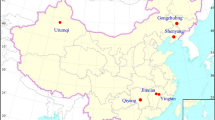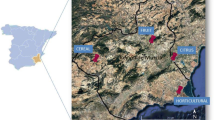Abstract
The use of phosphate fertilizers is essential in agriculture, because they supply farmland with nutrients for growing plants. However, heavy metals might be included as impurities in natural materials and minerals, so heavy metals can also be present in phosphate fertilizers or other chemical fertilizers. The aim of this work was to assess the heavy metal content and contamination status of agricultural soils in the Hamadan province of Iran used for the cultivation of different crops, including cucumber, potatoes, and sugar beet. Surface soil samples were collected and analyzed to determine the total concentration of specific elements (As, Cd, Cr, Cu, Fe, Mn, Ni, Pb, and Zn), before the pollution index was calculated for each element. Soils used for the cultivation of the three types of crop were not contaminated with As, Cr, Cu, Pb, or Zn. However, the pollution indices for Cd were 1.1, 4.4, and 3.8 in cucumber, potato, and sugar beet fields, respectively, which indicated moderate, high, and high levels of contamination, respectively. Soils from potato and sugar beet fields were heavily contaminated with Cd, which may have resulted from long-term overuse of phosphate fertilizers.
Similar content being viewed by others
Explore related subjects
Discover the latest articles, news and stories from top researchers in related subjects.Avoid common mistakes on your manuscript.
Introduction
Soil is a long-term sink for the potentially toxic elements usually referred to as heavy metals. The harmful effects of heavy metal pollution on the soil environment and human health, and their control, are currently a hot topic in the environmental research field [9, 12, 22, 24, 25]. Heavy metals are characterized by long residual periods, low visibility, low transfer, high toxicity, and the complexity of their chemical behaviors and eco-reactions [4]. They are also capable of entering the food chain [33]. Heavy metals are absorbed by crops, and they find their way into water and air by means of transfer, which poses a threat to the health of humans and animals [26, 29].
Fertilizers enhance the natural fertility of soil and replace the chemical elements taken from the soil by harvesting, grazing, leaching, or erosion [32]. Phosphorus is taken up by plants in a water-soluble form as H2PO −4 , HPO 2−4 , and PO 3−4 . Phosphate fertilizers are essential for agriculture because they supply farmland with nutrients for growing plants. Phosphates are also important constituents of animal feed stocks, as well as being used by the food industry and other chemical industries [7, 10]. The world phosphate rock consumption approaches 150 million tons annually, and about 95% is consumed by the fertilizer industry [2]. The majority of the world's phosphate resources are accessed via sulfuric or nitric acid attack of phosphate rocks [31]. Phosphate rocks are natural mineral deposits that bear phosphorus and calcium, which belong to the apatite family. These ores contain levels of trace metal contaminants that vary over a wide range, depending on their geological origin and geographical location [1]. World phosphate resources are distributed approximately as follows, according to their type: 75% from sedimentary marine deposits; 15–20% from igneous, metamorphic, and weathered deposits; and 2–3% from biogenic sources, i.e., bird and bat guano accumulations [15, 30]. Metal concentrations found in rock phosphate are variable, depending on their source of origin. Igneous rocks contain lower concentrations, whereas sedimentary rocks contain higher concentrations [27]. Heavy metals might occur as impurities in natural materials and minerals, so heavy metals can be present in phosphorus fertilizers or other chemical fertilizers. Rock phosphate and phosphorus fertilizers were found to contain the following levels: cadmium (Cd) 9.5–96.4 mg kg−1, arsenic (As) 19.4–273.0 mg kg−1, lead (Pb) 5.6–17.2 mg kg−1, and mercury (Hg) 0.01–0.42 mg kg−1 [20], Levels of As were found to be 50–60 mg kg−1 in ammonium nitrate, ammonium phosphate, and compound fertilizers [19]. A previous survey [18] also provided a clear picture of trace metal concentrations in various rock phosphate deposits (Table 1).
Little information is available on the effects of long-term overuse of chemical fertilizers, especially phosphate fertilizers, and the subsequent accumulation of heavy metals from them in agricultural soils. This study focused on analyzing the heavy metal content and contamination status of agricultural soils in the Hamadan province of Iran used for the cultivation of different crops, including cucumber, potatoes, and sugar beet. The results will provide a scientific basis for improving environmental quality in agricultural soils.
Materials and Methods
Soil Sampling and Analysis
Soil samples were collected from the surface (0–20 cm) in the Hamadan province of western Iran. The selected areas were used for the cultivation of three types of crop, i.e., cucumbers, potatoes, and sugar beet, the last of which consumed more phosphate fertilizer than the others. Each sampling area was greater than 2,000 m2, 8 ha, and 4 ha for cucumbers, potato, and sugar beet, respectively, and a total of 60, 180, and 30 soil samples were collected from the respective field types. Soil samples were air-dried and ground before being passed through a 2-mm sieve prior to analysis. One sample from each treatment received three replicate analyses. Soil characteristics are shown in Table 2.
The electrical conductivity (EC) and pH of soils were measured in a 1:5 (w/v) soil/water mixture. Soil samples were digested using aqua regia (HCl/HNO3, 3:1 solution)–HClO4 [21], and the concentrations of total As, Cd, Cr, Cu, Fe, Mn, Ni, Pb, and Zn were determined by ICP-AES.
Fertilizer application rates were averaged. Annual phosphate fertilizer application rates were considered to be the total amount of the phosphate fertilizer applied for the first and second crops each year.
Pollution Index
The pollution index was calculated using the following formula [35]:
where P i represents the pollution index of the pollutant i in the soil, C i is the concentration of the pollutant I in the soil, and S i denotes the assessment standard of the pollutant i (n.b., these values were 15, 0.2, 90, 35, 35, and 100 mg kg−1 of air-dried soil, respectively, for As, Cd, Cr, Cu, Pb, and Zn). P i ≤ 0.7 indicates that a soil is not contaminated with heavy metals. 1 < P i ≤ 2 indicates low pollution, 2 < P i ≤ 3 indicates moderate pollution, while P i > 3 indicates heavy pollution (Environmental Quality Standard for Soils, GB15618-1995).
Results
pH and EC of the Soils
Mean EC values of the treated soil samples ranged from 0.152 to 0.437, 0.262 to 0.815, and 0.341 to 0.718 dS m−1, respectively, for the soils used in the cultivation of cucumber, potatoes, and sugar beet. The mean pH values of the treated soil samples ranged from 7.1 to 8.12, 7.6 to 8.56, and 7.3 to 7.87, respectively, for soils used for cucumber, potatoes, and sugar beet.
Heavy Metal Content of Soils
Recent trends toward agricultural intensification have resulted in a dramatic increase in fertilizer usage. Our results show significantly higher total soil contents for the following: As, Cr, Cu, Mn, Ni, and Pb in soils from sugar beet fields; Cd, Pb, Cr, As, and Cd for soils from potato fields; and Fe and Zn for soils from both potato and sugar beet fields (Table 2).
We also tested whether ion concentrations were correlated with each other (Table 3). There was a positive correlation between heavy metals. Regressions between Ni vs. Cu, Fe vs. Mn, and Mn vs. Cu and Fe, were significant (r 2 > 0.90) in cucumber and potato fields. There was also a strong correlation between Mn vs. Fe (r 2 > 0.90) in sugar beet fields.
There was no significant correlation for As vs. any ions in potato and sugar beet fields, whereas the remaining elements showed only weak relationships with others. This suggested that the As content of soils came from a source other than fertilizer.
Pollution resulting from single heavy metals is found in nature, whereas synchronous pollution with several heavy metals is defined as combined heavy metal pollution. The high correlation between several heavy metals indicated multiple (combined heavy metal) pollution due to intensive agriculture.
Pollution Index
The pollution indices of soil As, Cr, Cu, Pb, and Zn, which were based on the Environmental Quality Standard for Soils, were lower than the critical value (0.7) for cucumber, potato, and sugar beet fields (Table 4), which indicates that soils from the three forms of cultivation were not contaminated with As, Cr, Cu, Pb, and Zn. However, the pollution indices for Cd were 1.1, 4.4, and 3.8 for cucumber, potato, and sugar beet fields, respectively, which indicates moderate, high, and high levels of contamination, respectively.
Discussion
Heavy metals can enter the environment by natural and anthropogenic means. The most significant natural sources are the weathering of minerals, erosion, and volcanic activity. Anthropogenic sources include the extraction and processing of minerals, especially phosphate rock, industrial processes, waste, and the application of phosphate fertilizers to soil [14]. Phosphate fertilizers contain heavy metals, where the amount present depends upon the source of the fertilizer, with some containing significant amounts of metal impurities, particularly Cd [34]. The persistent application of phosphate fertilizers has led to metal accumulation in soils. Our results are supported by those of Biasioli et al. [6], who found that Pb, Zn, and Cu were well correlated in urban soils from Turin in Italy, thereby confirming their mainly anthropogenic origin. Huang and Jin found combined heavy metal pollution in agricultural soils under different patterns of land use, which substantiates the correlation coefficients obtained for the seven heavy metals we analyzed [13]. It is also known that Cu, Zn, Pb, and Cd are common anthropogenic elements in agricultural soils [3, 11, 28].
The pollution indices of the studied soils suggested serious pollution in potato and sugar beet fields. The Cd input in soils is mainly derived from deposition, phosphate fertilizers, sewage sludge, and farmyard manure [5, 16, 23]. Previous studies also demonstrated the accumulation of Cd in soils mainly from long-term overuse of phosphate fertilizers and organic manures [25, 35]. Ju et al. reported that the increase in soil Cd concentrations in Huimin county, Shandong province, China, was mainly attributable to high levels of phosphate fertilizer and manure application [17]. Carnelo et al. reported that the application of conventional inorganic phosphorus fertilizers in Argentina led to soil contamination with Cd, Cr, Cu, Zn, Ni, and Pb [11]. Nicholson et al. (2003) pointed out that phosphate fertilizers are an important source of heavy metals entering agricultural soils in England and Wales, particularly Zn, Cu, and Cd [25]. Thus, the long-term overuse of phosphorus fertilizers, or other chemical fertilizers, with a relatively high content of Cd and other heavy metals may lead to the inadvertent addition of heavy metals to soils, which could potentially result in heavy metal pollution of soils.
Conclusion
Cd, Cu, Zn, and other heavy metals are found in some phosphorus fertilizers and other chemical fertilizers. The long-term overuse of chemical fertilizers can lead to the accumulation of Cd, Cu, Zn, and other heavy metals in agricultural soils. This study found that soils sampled from potato and sugar beet fields had high levels of Cd contamination. Pollution indices for Cd were 1.1, 4.4, and 3.8 in cucumber, potato, and sugar beet fields, respectively. This indicates moderate, high, and high levels of contamination, respectively. Cd has strong chemical activity in soils, and it is easily absorbed by plants, thereby entering the food chain [8, 33]. More attention should be paid to reducing the accumulation of heavy metals in soils by more rational use of phosphate fertilizers, particularly in the potato and sugar beet fields located in our test area.
References
Abdulla W, Dahl R (1999) The determination of cadmium and six other heavy metals in nitrate/phosphate fertilizer solution by ion chromatography. Anal Chim Acta 391:35–42
Abouzeid AZM, Abouzeid AT, Negm DA et al (2009) Upgrading of calcareous phosphate ores by flotation: effect of ore characteristics. Int J Miner Process 90:81–89
Alexandrovskaya EI, Alexandrovskiv AL (2000) History of the cultural layer in Moscow and accumulation of anthropogenic substances in it. Catena 41:249–259
Alloway BJ (1995) In: Barth Hy, L'Hermite P (eds) Heavy metals in soils. Blackie Academic and Professional, London, pp 38–57
Andersson A (1992) Trace elements in agricultural soils-fluxes, balances and background values. Swedish Environmental Protection Agency. Report, pp 4077
Biasioli M, Barberis R, Ajmone-Marsan F (2006) The influence of a large city on some soil properties and metal content. Sci Total Environ 356:154–164
Cajuste LJ, Garcia OC, Cruz DJ (2006) Distribution and availability of heavy metals in raw and acidulated phosphate rock-amended soils. Commun Soil Sci Plant Anal 37:2541–2552
Chai SW, Wen YM, Zhang YN et al (2003) The heavy metal content character of agriculture soil in Guangzhou suburbs (in Chinese). China Environ Sci 23:592–596
Chen TB, Wong MH, Wong JMC (1997) A study on heavy metal pollution in soil in Hong Kong (in Chinese). Acta Geogr Sin 52:228–236
Chen W, Chang AC, Wu L (2007) Assessing long-term environmental risks of trace elements in phosphate fertilizers. Ecotoxicol Environ Saf 67:48–58
Giuffrede Lopez Carnelo L, Ratto de Miguez S, Marban L (1997) Heavy metals input with phosphate fertilizers used in Argentina. Sci Total Environ 204:245–250
Hassan MJ, Wang F, Ali S et al (2005) Toxic effect of cadmium on rice as affected by nitrogen fertilizer form. Plant and Soil 277:359–365
Huang SW, Jin JY (2008) Status of heavy metals in agricultural soils as affected by different patterns of land use. Environ Monit Assess 139:317–327
Isil A, Firat A, Saydut A et al (2010) Hazardous metal geochemistry of sedimentary phosphate rock used for fertilizer (Mazıdag, SE Anatolia, Turkey). Microchem J 96:247–251
Jiang SY, Zhao HX, Chen YQ et al (2007) Trace and rare earth element geochemistry of phosphate nodules from the lower Cambrian black shale sequence in the Mufu Mountain of Nanjing, Jiansu province China. Chem Geol 244:584–604
Jones KC, Symon CJ, Johnston AE (1987) Retrospective analysis of an archived soil collection II. Cadmium. Sci Total Environ 67:75–89
Ju XT, Kou CL, Christie P et al (2007) Changes in the soil environment from excessive application of fertilizers and manures to two contrasting intensive cropping systems on the North China Plain. Environ Pollut 145:497–506
Kongshaug G, Bùckman OC, Kaarstad O, et al (1992) Paper presented at the International Symposium for Chemical Climatology and Geomedical Problems, Oslo, Norway
Li SP (2002) Environmental biology (in Chinese). Chinese Agricultural Press, Beijing, pp 426–442
Lin CG (1996) Soil pollution and its control (in Chinese). Chinese Agricultural Press, Beijing, pp 44–58
Lu RK (2000) Soil and agricultural chemistry analysis (in Chinese). Chinese Agricultural Press, Beijing, pp 321–330
Markus JA, Mcbranthey AB (1996) An urban soil study: heavy metals in Globe, Australia. Aust J Soil Res 34:453–465
McLaughlin MJ, Parker DR, Clarke JM (1999) Metals and micronutrients—food safety issues. Field Crop Res 60:143–163
Mebride M, Sauve S, Hendershot W (1997) Solubility control of Cu, Zn, Cd and Pb in contaminated soils. Eur J Soil Sci 48:337–346
Nicholson FA, Smith SR, Alloway BJ et al (2003) An inventory of heavy metal inputs to agricultural soils in England and Wales. Sci Total Environ 311:205–219
Nriagu JO, Pzcyna JM (1988) Quantitative assessment of worldwide contamination of air, water, and soil by trace metals. Nature 333:134–139
Nziguheba G, Smolders E (2008) Inputs of trace elements in agricultural soils via phosphate fertilizers in European countries. Sci Total Environ 390:53–57
Pouyat RV, McDonnell MJ (1991) Heavy metal accumulations in forest soils along an urban rural gradient in southeastern New York, USA. Water Air Soil Pollut 57:797–807
Qian S, Wang Z, Tu Q (1996) Distribution and plant availability of heavy metals in different particle-size fractions of soils. Sci Total Environ 187:131–141
Sengul H, Ozer AK, Gulaboglu MS (2006) Benefication of Mardin-Mazidagi (Turkey) calcareous phosphate rock using dilute acetic acid solutions. Chem Eng J 122:135–140
Slack AV (1968) Phosphoric acid, part II, ch. 6 ± 8. Marcel Dekker, New York
Tekin T, Tekin D, Bayramoglu M (2001) Effect of ultrasound on the dissolution kinetics of phosphate rock in HNO3, Ultrason. Sonochem 8:373–377
Wagner GJ (1993) Accumulation of cadmium in crop plants and its consequences to human health. Adv Agron 51:73–212
Zhang H, Shan B (2008) Historical distribution and partitioning of phosphorus in sediments rich in an agricultural watershed in the Yangtze–Huaihe Region, China. Environ Sci Technol 42:2328–2333
Zheng GZ, Yue LP, Li ZP et al (2006) Assessment on heavy metal pollution of agricultural soil in Guangzhong district. J Geogr Sci 16:105–113
Acknowledgments
The authors would like to express their appreciation to Islamic Azad University–Hamedan Branch for its facilities and kind support.
Author information
Authors and Affiliations
Corresponding author
Rights and permissions
About this article
Cite this article
Cheraghi, M., Lorestani, B. & Merrikhpour, H. Investigation of the Effects of Phosphate Fertilizer Application on the Heavy Metal Content in Agricultural Soils with Different Cultivation Patterns. Biol Trace Elem Res 145, 87–92 (2012). https://doi.org/10.1007/s12011-011-9161-3
Received:
Accepted:
Published:
Issue Date:
DOI: https://doi.org/10.1007/s12011-011-9161-3




